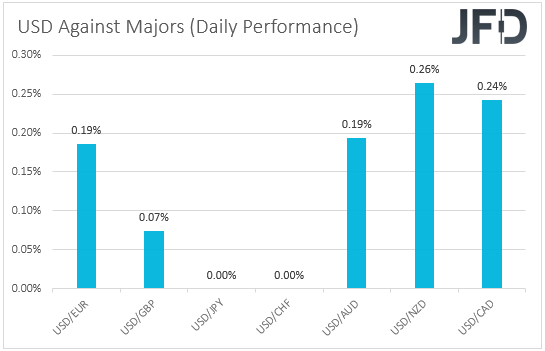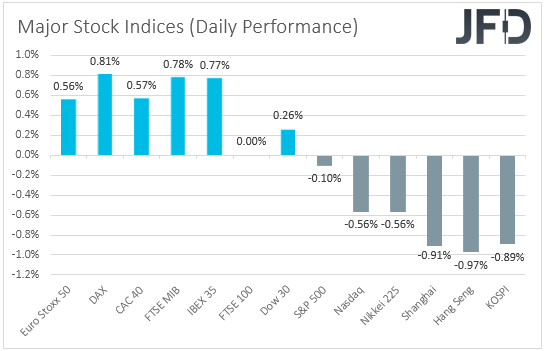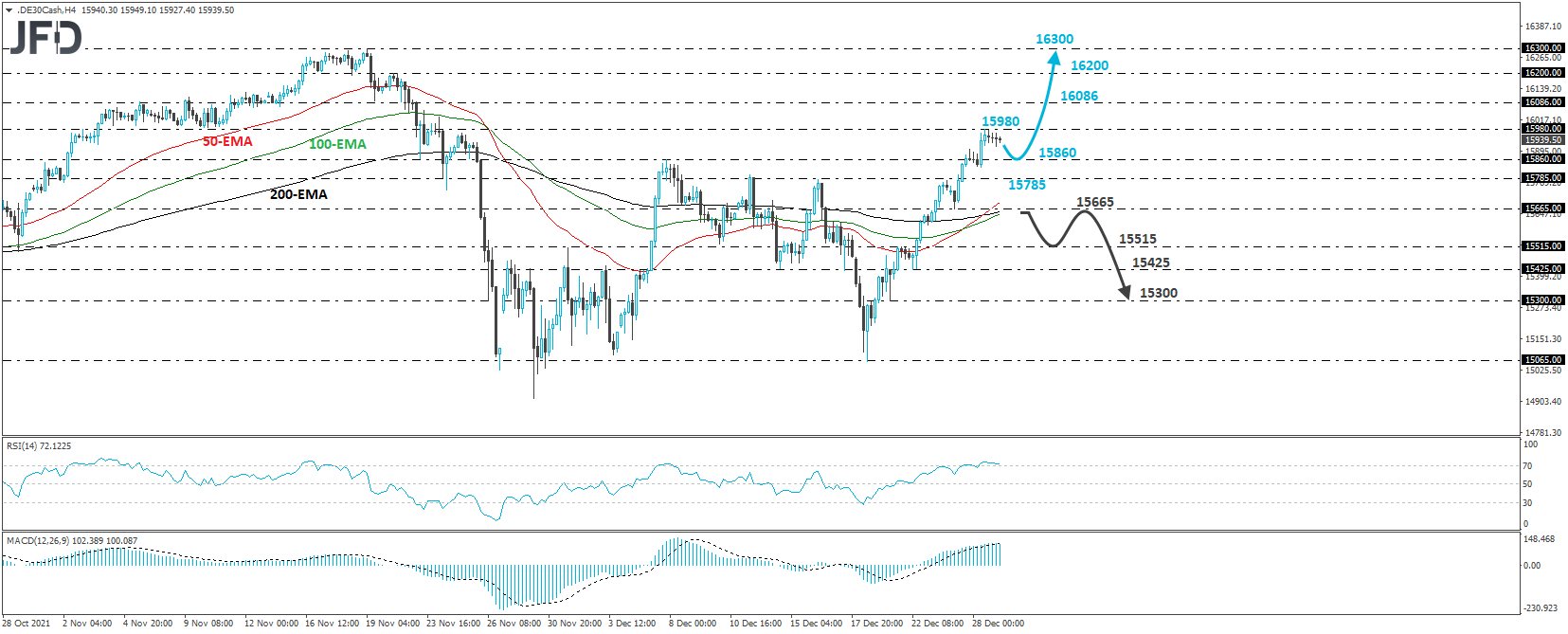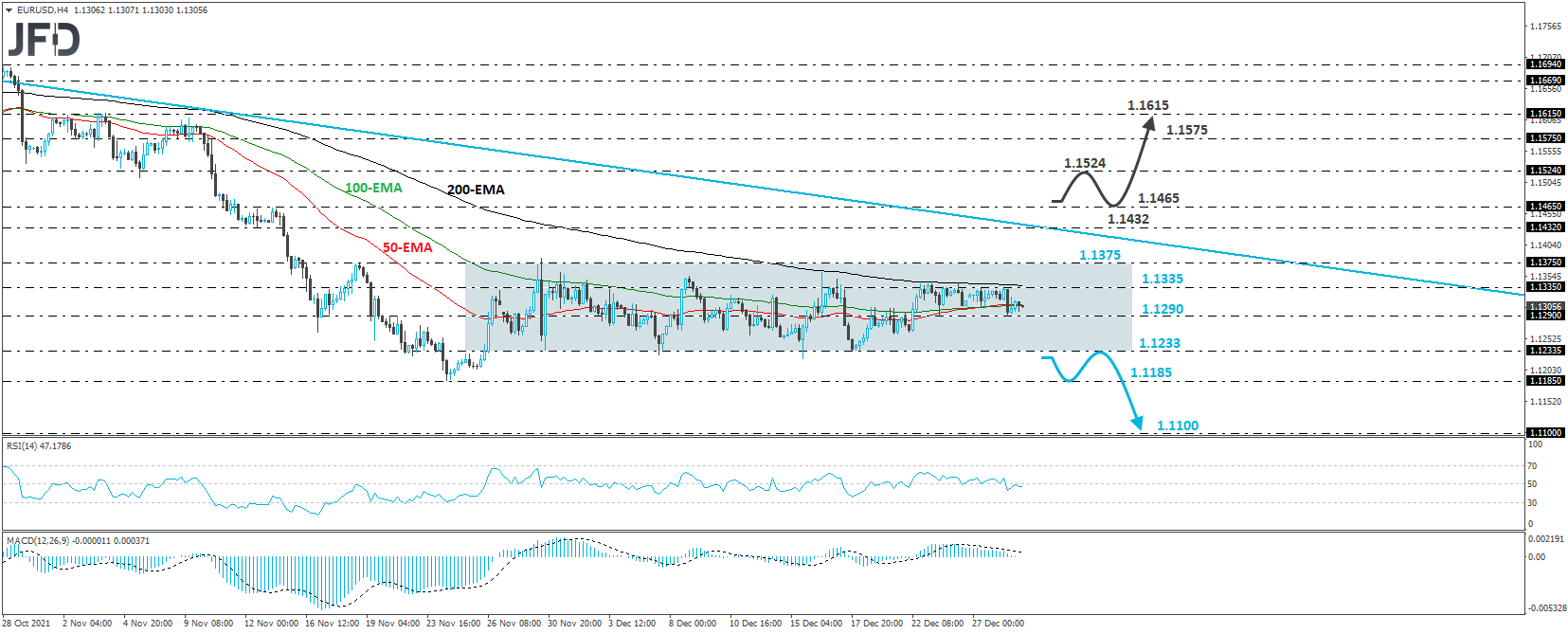The US dollar and the other safe-haven currencies, the yen, and the franc, traded higher against the other major currencies yesterday and today in Asia, while risk-linked assets corrected lower. With a very light economic agenda, and no major market-specific headlines, it could be the surging COVID cases, or maybe investors are closing their books for the year.
US Dollar and Other Safe-Havens Rebound, Risky Assets Pull Back
The US dollar traded higher against all but two of the other major currencies on Tuesday and during the Asian session Wednesday. The currencies against which it failed to eke out any gains were JPY and CHF, with USD/JPY and USD/CHF found virtually unchanged this morning. The greenback strengthened the most versus NZD, CAD, AUD, and EUR.
The strengthening of the US dollar, and the other safe-havens, yen, and franc, combined with the weakening of the risk-linked currencies Kiwi, Loonie and Aussie, suggests that markets may have turned to risk-off at some point yesterday.
Major EU indices traded in the green, but the picture turned more mixed during the US session, and deteriorated even further today in Asia.

It is hard to identify the actual driver with a very light economic agenda, thin liquidity, and no straightforward headlines to support the switch in appetite. It could be the surging COVID cases around the globe, or maybe investors are closing their books for the year.
In any case, yesterday’s pullback is far from pointing to a trend reversal. With media suggesting that the fast spreading of the Omicron COVID variant is unlikely to lead to global lockdowns again due to its milder symptoms, investors may decide to reignite the so-called “Santa Rally” for the remainder of the week.
However, we repeat that we are reluctant to call for a long-lasting recovery. Although the prospect of a full-scale global lockdown may be off the table, for now, several nations may be waiting to tighten existing restrictions after the holiday season.
With also most major central banks being in the process of removing stimulus due to extremely high inflation, and not willing to resume rescue programs to treat any potential economic wounds that may result in due to additional restrictions, we cannot rule out some decent setbacks in the markets after the turn of the year.
DAX – Technical Outlook
The German DAX cash index has been in a recovery mode since Dec. 20, when it hit support at 15065. It cleared the 15860 zone, marked by the high of Dec. 7, and hit resistance at 15980. In our view, with no signs that the recovery is running out of steam, we would expect it to continue for a while more.
A clear break above 15980 would confirm a forthcoming higher high and may target the inside swing low of Nov. 19, at 16086, the break of which could extend the advance towards the high of Nov. 22, at 16200. If investors are not willing to stop there either, we may see them hitting once again the index’s record of 16300.
We will start considering the case of a substantial correction lower if we see a break below 15665, which is the low of Dec. 27. Market participants may then allow the index to slide towards the 15515 barrier, the break of which could trigger extensions towards the low of Dec. 22, at 15425.
If there are no buyers near that support either, then we could experience declines towards the low of the day before, at around 15300.
EUR/USD – Technical Outlook
EUR/USD traded somewhat lower yesterday after it hit resistance again at 1.1335. That said, the slide was stopped, at least for now, near the 1.1290 level. Overall, the pair remains within the sideways range that’s been in place since Nov. 26, between the 1.1233 and 1.1375 barriers. Still, it also trades below the downside resistance line taken from the high of May 25, which, in our view, increases the chances for a downside exit out of the range rather than an upside one.
If the bears are strong enough to push the pair below the lower end of the range, which is at 1.1233, we may initially see them targeting the low of Nov. 24, at 1.1185. If they are unwilling to stop there and manage to overcome that obstacle, this will confirm a forthcoming lower low on the weekly chart and may pave the way towards the 1.1100 area, which provided support back on Jun. 1, 2020.
On the upside, we would like to see a strong recovery above 1.1465 before we start examining the bullish case. The rate will already be above the aforementioned medium-term downside line, and the bulls could initially climb towards the 1.1524 zone, which supported the action back on Oct. 12 and Nov. 5. If they don’t stop there, we may experience advances towards the 1.1575 barrier, or the 1.1615 zone, marked by the low of Nov. 9, and the high of Nov. 4, respectively.

Elsewhere
The only releases worth mentioning on today’s schedule are the US pending home sales for November and the EIA report on crude oil inventories for last week. Pending home sales are expected to have slowed notably, to +0.5% mom from +7.5%, while the EIA report is forecast to show that inventories have slid by 3.233mn barrels after falling by 4.715mn the week before.
